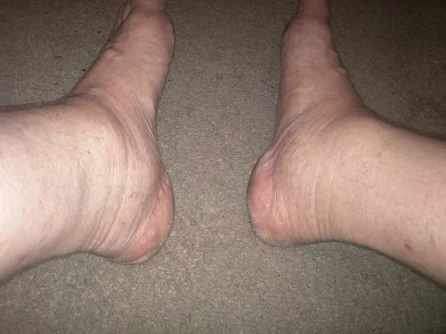My feet are a little swollen on testosterone and i recently got a bad cellulitis ( which might be due to the swollen feet). Any ideas how to prevent this from happening? I would like to hear medicine ideas or any supplements that are over the counter. I hope this resolves over time. I'm on trt for close to a year . Thanks for your help
You are using an out of date browser. It may not display this or other websites correctly.
You should upgrade or use an alternative browser.
You should upgrade or use an alternative browser.
Does testosterone cause swelling of feet? How to fix
- Thread starter rimster
- Start date
-
- Tags
- ankle swelling
Systemlord
Member
That depends on what’s causing the swelling. I had iron deficiency without anemia and my feet swelled up and became numb. If it’s fluid retention, either decreasing your dosage or a diuretic may be needed.My feet are a little swollen on testosterone and i recently got a bad cellulitis ( which might be due to the swollen feet). Any ideas how to prevent this from happening? I would like to hear medicine ideas or any supplements that are over the counter. I hope this resolves over time. I'm on trt for close to a year . Thanks for your help
You can try dandelion root, which is a natural diuretic.
You need to watch your salt intake.
Do you think it's fluid retention if it's only my feet and ankles mainly that are swollen. Nothing else is swollenThat depends on what’s causing the swelling. I had iron deficiency without anemia and my feet swelled up and became numb. If it’s fluid retention, either decreasing your dosage or a diuretic may be needed.
You can try dandelion root, which is a natural diuretic.
You need to watch your salt intake.
Check your scale. I gained nearly 15lbs of water weight during my first go with Cypionate.Do you think it's fluid retention if it's only my feet and ankles mainly that are swollen. Nothing else is swollen
That's what I'm saying. I didn't gain weight . I tried taking an over the counter diuretic a half dose and i got dehydrated for two days from it. So I'm not sure if it's water retentionCheck your scale. I gained nearly 15lbs of water weight during my first go with Cypionate.
Deleted member 16042
Member

What medications cause swollen ankles and feet?
Official answer: Swelling in your ankles and feet is called peripheral edema. Many medications can cause this swelling. Calcium channel...

Systemlord
Member
Did you have feet swelling when you were dehydrated?I tried taking an over the counter diuretic a half dose and i got dehydrated for two days from it. So I'm not sure if it's water retention
If not then it might be blood flow related.
Nelson Vergel
Founder, ExcelMale.com
You may need an ABI test. Read this thread and in particular post #9.

 www.excelmale.com
www.excelmale.com
You may want to talk to your doctor.
Ankle swelling after starting testosterone injections - Excel Male TRT Forum
I got this question from a friend of mine today who started testosterone replacement 3 weeks ago (injections of 100 mg per week): "I've been gaining a lot of weight. Does this mean my estradiol is high? I don't have any nipple soreness or severe bloating but my ankles and wrist...
You may want to talk to your doctor.
Hi i raised my feet during sleep and it basically fixed the issue. Do i still need the testYou may need an ABI test. Read this thread and in particular post #9.

Ankle swelling after starting testosterone injections - Excel Male TRT Forum
I got this question from a friend of mine today who started testosterone replacement 3 weeks ago (injections of 100 mg per week): "I've been gaining a lot of weight. Does this mean my estradiol is high? I don't have any nipple soreness or severe bloating but my ankles and wrist...www.excelmale.com
You may want to talk to your doctor.
Nelson Vergel
Founder, ExcelMale.com
I think every man over 40 should have that test included in their annual physical. My doctor has been doing that with us for over 20 years. It's low tech and fast.
Markee
Member
I've been on TRT for a long time already over 25yrs. For the past few years, I'm having the same issue pretty bad swelling in my feet and ankles. My primary care doctor sent me to a Vascular surgeon who thought for sure I had CVI or Chronic Venous Insufficiency it's a common issue as you get older the vein valves in your legs break down. So after a bunch of testing taking about a year and a half of ultrasound imaging done 3x every 6 months they ruled out it's not CVI said must be a heart issue sent me to a Cardiologist who did an Echo Echocardiogram, CT Coronary Angiogram, and CAC Calcium Score test and my Calcium score was 0, conclusion nothing wrong with my heart, not a heart problem then they sent me to Nephrologist Kidney specialist because my eGFR 58 is considered a little low turned out it was from a lifetime of chronic NSAIDs usage stopped taking it my eGFR came right back to normal so its, not a kidney issue. At this point, nobody knows what was causing it. Switched from injectable Cyp. to the cream 2 clicks a day seemed to go away for a while thought for sure had to be the injectable but it came back again now I'm down to 1 click a day and stopped all HCG for a while still can't figure out what's causing it any suggestions?
Attachments
I wonder if ur answer lies in the reason that it went away briefly when u switched from cyp to the cream. I wonder if we can all brainstorm and possibly figure out the reason that this occurred, and then replicate it somehow. How long did it go away for?I've been on TRT for a long time already over 25yrs. For the past few years, I'm having the same issue pretty bad swelling in my feet and ankles. My primary care doctor sent me to a Vascular surgeon who thought for sure I had CVI or Chronic Venous Insufficiency it's a common issue as you get older the vein valves in your legs break down. So after a bunch of testing taking about a year and a half of ultrasound imaging done 3x every 6 months they ruled out it's not CVI said must be a heart issue sent me to a Cardiologist who did an Echo Echocardiogram, CT Coronary Angiogram, and CAC Calcium Score test and my Calcium score was 0, conclusion nothing wrong with my heart, not a heart problem then they sent me to Nephrologist Kidney specialist because my eGFR 58 is considered a little low turned out it was from a lifetime of chronic NSAIDs usage stopped taking it my eGFR came right back to normal so its, not a kidney issue. At this point, nobody knows what was causing it. Switched from injectable Cyp. to the cream 2 clicks a day seemed to go away for a while thought for sure had to be the injectable but it came back again now I'm down to 1 click a day and stopped all HCG for a while still can't figure out what's causing it any suggestions?
Nelson Vergel
Founder, ExcelMale.com
Wow! You really went through the whole differential diagnosis process. It's great that you have nothing going on with your heart and kidneys.still can't figure out what's causing it any suggestions?
I would take a mild potassium-sparing diuretic like amiloride and see what happens.
Venous insufficiency: This condition occurs when your leg veins have problems sending blood back to your heart. This can cause blood to pool in your legs, leading to swelling.
Heart failure: Heart failure can cause fluid to accumulate in the body, leading to edema in the lower extremities, such as the ankles.
Kidney disease: Your kidneys remove waste and extra fluid from your body. If they're not functioning properly, fluid can build up, causing swelling in the legs and ankles.
Liver disease: Liver disease can also lead to fluid accumulation in the lower body, causing swelling in the ankles and legs.
Lymphedema: This condition, characterized by blockage in the lymphatic system, can cause swelling in the legs and ankles.
Medications: Certain drugs, including antihypertensives, steroids, and nonsteroidal anti-inflammatory drugs (NSAIDs), can cause ankle edema.
Pregnancy: Swelling in the ankles and feet is common in pregnancy due to increased body fluid and pressure on veins from the growing uterus.
Injury or infection: If the swelling is localized to one ankle, it may be due to an injury like a sprain, fracture, or infection.
Have you looked at liver and lymphatic tissue?
These are tests for lymphedema:
Imaging tests: These could include MRI (Magnetic Resonance Imaging), CT (Computed Tomography) scans, Doppler ultrasound, or lymphoscintigraphy (a special type of imaging that uses a radioactive dye to visualize the lymphatic system).
Bioimpedance analysis: This is a non-invasive method that measures the resistance to an electrical current passed through the body to detect fluid changes.
Lymphography: This is a less commonly used invasive method where a dye is injected into the lymphatic system and X-rays are taken to see the flow of lymph. This test has largely been replaced by lymphoscintigraphy.
The primary goal of lymphedema treatment is to reduce swelling and control discomfort and other symptoms. Although lymphedema is typically a chronic condition that can't be cured, it can often be managed effectively with a combination of therapies. Here are some commonly used approaches:
Compression therapy: Compression garments, such as stockings or sleeves, can encourage fluid to flow back out of the affected limb. Bandages might also be used for the same purpose, and they can be especially useful because they can be adjusted to fit areas of the body where the swelling is greatest.
Manual lymph drainage: This is a specialized form of massage where a trained therapist uses gentle, rhythmic pumping movements to stimulate the flow of lymph. This helps to move fluid from swollen areas to areas where the lymphatic system is working normally.
Exercise and physical therapy: Specific exercises can help improve lymph drainage. Physical therapy might also include range-of-motion exercises to improve mobility if the lymphedema is restricting movement.
Pneumatic compression: This therapy involves wearing a sleeve over the affected limb, which is connected to a pump that intermittently inflates to provide pressure and promote lymph flow.
Complete decongestive therapy (CDT): This is a comprehensive approach that includes a combination of manual lymphatic drainage, compression garments or bandaging, skin care, and exercises.
Skin care: Keeping the skin clean and moisturized helps prevent infections, which can worsen lymphedema.
Diet and lifestyle modifications: Maintaining a healthy weight and staying active can help manage lymphedema. It's also essential to avoid injury or infection to the affected limb, as these can exacerbate the condition.
In some cases, if conservative methods are not successful, surgery may be considered. There are several surgical options, including lymphatic bypass procedures, lymph node transplant, or procedures to remove excess tissue in severe cases of lymphedema.
Above content from ChatGPT.
Last edited:
I’m glad I saw this, I’m back on cream from Enanthate and BAM… sausage ankles… WTH…
Went for a couple of hikes with the wife today in 98* heat… still a bit swollen. Going to have to have a chat with my new T-Doc if this keeps up. Crappy part is, compounded cream costs me $5usd for 90gm with my insurance, T-Enanthate costs me $155 for 10ml, and money is tight.
Went for a couple of hikes with the wife today in 98* heat… still a bit swollen. Going to have to have a chat with my new T-Doc if this keeps up. Crappy part is, compounded cream costs me $5usd for 90gm with my insurance, T-Enanthate costs me $155 for 10ml, and money is tight.
What helped me also is socks that are compression socks for the ankles. I bought them on Amazon and it made a big difference.I’m glad I saw this, I’m back on cream from Enanthate and BAM… sausage ankles… WTH…
Went for a couple of hikes with the wife today in 98* heat… still a bit swollen. Going to have to have a chat with my new T-Doc if this keeps up. Crappy part is, compounded cream costs me $5usd for 90gm with my insurance, T-Enanthate costs me $155 for 10ml, and money is tight.
Nelson Vergel
Founder, ExcelMale.com
Peripheral Edema and Testosterone Replacement Therapy
Peripheral Edema in TRT: Peripheral edema refers to swelling caused by fluid accumulation in the limbs, often noticeable in the feet or ankles. It is a recognized side effect of testosterone replacement therapy (TRT) in men1. In fact, clinical resources list “swelling in your ankles caused by mild fluid retention” as a common side effect of TRT. This edema is typically mild in men receiving therapeutic doses, but it can be more pronounced in certain cases (especially at higher doses or in susceptible individuals). Patients on TRT are routinely monitored for signs of fluid retention, such as ankle swelling, as part of their care1.
Causes and Pathophysiology of Edema in TRT
Mechanisms of Fluid Retention: Testosterone has well-documented effects on fluid and electrolyte balance. It promotes sodium and water retention, which in turn increases blood volume1. This is partly why TRT can lead to edema, hypertension, or even exacerbate heart failure in vulnerable patients1. The salt and water retaining effect of testosterone appears to be due to both direct and indirect mechanisms:
Direct Renal Effects: Testosterone likely acts on the kidneys to enhance tubular reabsorption of sodium and water. Clinical research has shown that testosterone therapy increases extracellular water volume independent of changes in renin-angiotensin levels. In hypogonadal men, testosterone administration was proven to expand extracellular fluid volume, indicating a direct renal effect on fluid retention. This means the hormone itself can cause the kidneys to hold on to more salt and water, contributing to edema.
Hormonal Conversions (Estrogen): A portion of exogenous testosterone is converted (aromatized) to estradiol. Estrogen is known to cause fluid retention as well – for example, women on estrogen therapy and even men on testosterone can develop leg swelling due to hormonal water retention. Elevated estradiol levels can promote the renin-angiotensin system and water retention, compounding testosterone’s direct effects.
Increased Blood Volume and Pressure: Testosterone stimulates erythropoiesis (red blood cell production), sometimes leading to polycythemia (high hematocrit)1. Along with water retention, this increases blood volume. The higher intravascular volume can raise capillary hydrostatic pressure, pushing fluid into peripheral tissues. This is one reason edema tends to occur in gravity-dependent areas like the ankles. Studies note that anabolic-androgenic steroids cause sodium/water retention in the kidney, increasing blood volume and blood pressure. In older men or those with limited cardiac reserve, the added fluid load can precipitate or worsen congestive heart failure, which manifests as peripheral edema1.
Edema at Therapeutic Doses: In medically supervised TRT (e.g. restoring testosterone to normal physiologic levels), edema is usually mild to moderate. It often presents as ankle or leg swelling and may be more evident in older men1. Older individuals may be more sensitive due to age-related cardiac or renal impairments; indeed, “testosterone causes salt and water retention, particularly in older men”. Most trials of TRT in hypogonadal men report low incidence of significant edema, but it is a noted adverse effect. For example, a recent review on testosterone therapy safety lists leg edema among the observed side effects in clinical trials. Usually this edema is benign and reversible, but it warrants attention. Importantly, men with underlying conditions - heart failure, severe kidney disease, or liver disease - are at higher risk. TRT can worsen edema in patients with these conditions, so it must be used cautiously or avoided in such cases. (For instance, testosterone is contraindicated in men with uncontrolled congestive heart failure because of potential fluid overload.)
Edema at Supraphysiologic Doses: Men using supraphysiologic doses of testosterone or other anabolic-androgenic steroids (AAS) – often in non-medical contexts like bodybuilding – can develop more severe edema. High-dose androgens frequently lead to marked sodium retention and water retention, much more than therapeutic dosing. This “water bloat” contributes to rapid weight gain and elevated blood pressure in AAS users. One review noted that supratherapeutic androgen use is associated with dose-limiting side effects such as erythrocytosis and leg edema. In other words, beyond a certain dose, edema becomes a common and problematic effect. The pathophysiology is an exaggerated version of the mechanisms above – massive fluid retention from the kidneys and estrogen conversion, and strain on the cardiovascular system. Chronic high-dose steroid use also causes structural changes: left ventricular hypertrophy and cardiac dysfunction have been documented in long-term AAS users, which can lead to heart failure and peripheral edema. Additionally, prolonged steroid abuse can in rare cases injure the kidneys (for example, anabolic steroid abuse has been linked to focal segmental glomerulosclerosis, a kidney scarring condition). Such kidney damage causes protein loss and worsened edema. Thus, edema in a steroid user could indicate not just benign fluid retention but emerging cardiac or renal issues.
In summary, testosterone (and its high-dose analogs) induces peripheral edema via renal salt/water retention, increased estrogenic activity, and expanded blood volume1. Therapeutic TRT usually causes only mild ankle swelling, whereas supraphysiologic doses can produce significant edema with associated hypertension. Clinicians are advised to monitor for this side effect and evaluate any contributing factors (such as heart, kidney, or liver function).
Treatment and Management of TRT-Induced Edema
Managing peripheral edema in men on testosterone therapy involves a combination of addressing the underlying cause, adjusting the hormone therapy if possible, and employing measures to relieve the swelling. Approaches can be grouped into standard medical interventions, emerging/adjunct therapies, and lifestyle modifications:
Standard Medical Treatments
Conservative measures play a significant role in managing and preventing peripheral edema, whether caused by TRT or other factors. Many of these steps can be done by the patient at home to improve comfort and reduce swelling:
When peripheral edema in a man on TRT is appropriately managed, the outlook is generally good. Mild edema often resolves with conservative measures or dose adjustments. Many patients find that after the first few months on TRT, their body equilibrates and the ankle swelling diminishes. If the edema was related to an underlying issue that was unmasked by TRT (such as borderline heart failure), addressing that issue can significantly improve long-term outcomes. In summary, peripheral edema from testosterone therapy can range from a mild nuisance to a sign of serious cardiovascular stress. The pathophysiology involves testosterone’s effects on kidney sodium retention, fluid volume expansion, and possibly elevated estrogen levels, all of which can lead to swelling1. Treatment is multi-faceted: ensure the testosterone dose is appropriate, treat any medical conditions contributing, consider medications (like diuretics) if needed, and implement lifestyle changes to minimize fluid accumulation. Emerging therapies like SARMs hold promise for reducing such side effects in the future. With careful management, most men can continue the benefits of TRT without significant edema, or at least keep it at a manageable level.
Citations
Risks of testosterone replacement therapy in men - PMC
https://pmc.ncbi.nlm.nih.gov/articles/PMC3897047/
Testosterone Replacement Therapy (TRT): What It Is
https://my.clevelandclinic.org/health/treatments/testosterone-replacement-therapy-trt
Adverse Events Associated with Testosterone Administration - PMC
https://pmc.ncbi.nlm.nih.gov/articles/PMC3440621/
Androgens and Selective Androgen Receptor Modulators to Treat Functional Limitations Associated With Aging and Chronic Disease - PMC
https://pmc.ncbi.nlm.nih.gov/articles/PMC10272983/
Independent and combined effects of testosterone and growth hormone on extracellular water in hypopituitary men - PubMed
https://pubmed.ncbi.nlm.nih.gov/15827107/
Foot, leg, and ankle swelling: MedlinePlus Medical Encyclopedia
https://medlineplus.gov/ency/article/003104.htm
Anabolic-androgenic steroids and cardiovascular risk - PMC
https://pmc.ncbi.nlm.nih.gov/articles/PMC6797160/
Androgens and Selective Androgen Receptor Modulators to Treat Functional Limitations Associated With Aging and Chronic Disease - PMC
https://pmc.ncbi.nlm.nih.gov/articles/PMC10272983/
Testosterone (intramuscular route, subcutaneous route) - Mayo Clinic
https://www.mayoclinic.org/drugs-supplements/testosterone-intramuscular-route-subcutaneous-route/description/drg-20095183
Selective Androgen Receptor Modulators (SARMs) as Function Promoting Therapies - PMC
https://pmc.ncbi.nlm.nih.gov/articles/PMC2907129/
Adverse Events Associated with Testosterone Administration - PMC
https://pmc.ncbi.nlm.nih.gov/articles/PMC3440621/
Focal segmental glomerulosclerosis (FSGS) - Symptoms, causes ...
https://www.kidney.org/kidney-topics/focal-segmental-glomerulosclerosis-fsgs
Focal segmental glomerulosclerosis - Wikipedia
https://en.wikipedia.org/wiki/Focal_segmental_glomerulosclerosis
Edema: Causes, Symptoms & Treatment
https://my.clevelandclinic.org/health/diseases/12564-edema
7 Natural Diuretics: Herbs, Supplements, Foods, and Drinks
https://www.healthline.com/health/natural-diuretics
Foot, leg, and ankle swelling: MedlinePlus Medical Encyclopedia
https://medlineplus.gov/ency/article/003104.htm
Foot, leg, and ankle swelling: MedlinePlus Medical Encyclopedia
https://medlineplus.gov/ency/article/003104.htm
Androgens and Selective Androgen Receptor Modulators to Treat Functional Limitations Associated With Aging and Chronic Disease - PMC
https://pmc.ncbi.nlm.nih.gov/articles/PMC10272983/
Development of Focal Segmental Glomerulosclerosis after Anabolic Steroid Abuse - PMC
https://pmc.ncbi.nlm.nih.gov/articles/PMC2799287/
Focal segmental glomerulosclerosis (FSGS) - Symptoms, causes ...
https://www.kidney.org/kidney-topics/focal-segmental-glomerulosclerosis-fsgs
Peripheral Edema in TRT: Peripheral edema refers to swelling caused by fluid accumulation in the limbs, often noticeable in the feet or ankles. It is a recognized side effect of testosterone replacement therapy (TRT) in men1. In fact, clinical resources list “swelling in your ankles caused by mild fluid retention” as a common side effect of TRT. This edema is typically mild in men receiving therapeutic doses, but it can be more pronounced in certain cases (especially at higher doses or in susceptible individuals). Patients on TRT are routinely monitored for signs of fluid retention, such as ankle swelling, as part of their care1.
Causes and Pathophysiology of Edema in TRT
Mechanisms of Fluid Retention: Testosterone has well-documented effects on fluid and electrolyte balance. It promotes sodium and water retention, which in turn increases blood volume1. This is partly why TRT can lead to edema, hypertension, or even exacerbate heart failure in vulnerable patients1. The salt and water retaining effect of testosterone appears to be due to both direct and indirect mechanisms:
Direct Renal Effects: Testosterone likely acts on the kidneys to enhance tubular reabsorption of sodium and water. Clinical research has shown that testosterone therapy increases extracellular water volume independent of changes in renin-angiotensin levels. In hypogonadal men, testosterone administration was proven to expand extracellular fluid volume, indicating a direct renal effect on fluid retention. This means the hormone itself can cause the kidneys to hold on to more salt and water, contributing to edema.
Hormonal Conversions (Estrogen): A portion of exogenous testosterone is converted (aromatized) to estradiol. Estrogen is known to cause fluid retention as well – for example, women on estrogen therapy and even men on testosterone can develop leg swelling due to hormonal water retention. Elevated estradiol levels can promote the renin-angiotensin system and water retention, compounding testosterone’s direct effects.
Increased Blood Volume and Pressure: Testosterone stimulates erythropoiesis (red blood cell production), sometimes leading to polycythemia (high hematocrit)1. Along with water retention, this increases blood volume. The higher intravascular volume can raise capillary hydrostatic pressure, pushing fluid into peripheral tissues. This is one reason edema tends to occur in gravity-dependent areas like the ankles. Studies note that anabolic-androgenic steroids cause sodium/water retention in the kidney, increasing blood volume and blood pressure. In older men or those with limited cardiac reserve, the added fluid load can precipitate or worsen congestive heart failure, which manifests as peripheral edema1.
Edema at Therapeutic Doses: In medically supervised TRT (e.g. restoring testosterone to normal physiologic levels), edema is usually mild to moderate. It often presents as ankle or leg swelling and may be more evident in older men1. Older individuals may be more sensitive due to age-related cardiac or renal impairments; indeed, “testosterone causes salt and water retention, particularly in older men”. Most trials of TRT in hypogonadal men report low incidence of significant edema, but it is a noted adverse effect. For example, a recent review on testosterone therapy safety lists leg edema among the observed side effects in clinical trials. Usually this edema is benign and reversible, but it warrants attention. Importantly, men with underlying conditions - heart failure, severe kidney disease, or liver disease - are at higher risk. TRT can worsen edema in patients with these conditions, so it must be used cautiously or avoided in such cases. (For instance, testosterone is contraindicated in men with uncontrolled congestive heart failure because of potential fluid overload.)
Edema at Supraphysiologic Doses: Men using supraphysiologic doses of testosterone or other anabolic-androgenic steroids (AAS) – often in non-medical contexts like bodybuilding – can develop more severe edema. High-dose androgens frequently lead to marked sodium retention and water retention, much more than therapeutic dosing. This “water bloat” contributes to rapid weight gain and elevated blood pressure in AAS users. One review noted that supratherapeutic androgen use is associated with dose-limiting side effects such as erythrocytosis and leg edema. In other words, beyond a certain dose, edema becomes a common and problematic effect. The pathophysiology is an exaggerated version of the mechanisms above – massive fluid retention from the kidneys and estrogen conversion, and strain on the cardiovascular system. Chronic high-dose steroid use also causes structural changes: left ventricular hypertrophy and cardiac dysfunction have been documented in long-term AAS users, which can lead to heart failure and peripheral edema. Additionally, prolonged steroid abuse can in rare cases injure the kidneys (for example, anabolic steroid abuse has been linked to focal segmental glomerulosclerosis, a kidney scarring condition). Such kidney damage causes protein loss and worsened edema. Thus, edema in a steroid user could indicate not just benign fluid retention but emerging cardiac or renal issues.
In summary, testosterone (and its high-dose analogs) induces peripheral edema via renal salt/water retention, increased estrogenic activity, and expanded blood volume1. Therapeutic TRT usually causes only mild ankle swelling, whereas supraphysiologic doses can produce significant edema with associated hypertension. Clinicians are advised to monitor for this side effect and evaluate any contributing factors (such as heart, kidney, or liver function).
Treatment and Management of TRT-Induced Edema
Managing peripheral edema in men on testosterone therapy involves a combination of addressing the underlying cause, adjusting the hormone therapy if possible, and employing measures to relieve the swelling. Approaches can be grouped into standard medical interventions, emerging/adjunct therapies, and lifestyle modifications:
Standard Medical Treatments
- Adjusting the Testosterone Dose or Regimen: The first step is often to modulate the TRT itself. If a patient on TRT develops significant edema, the prescribing physician may lower the dosage or switch to a different delivery method. In many cases, reducing testosterone to the lowest effective dose can markedly improve edema. If edema remains severe, a temporary pause in therapy might be considered to allow fluid balance to normalize.
- Addressing Underlying Conditions: It is crucial to check for any precipitating condition. If edema is a sign of heart failure exacerbation, then optimizing heart failure therapy is necessary. If kidney function is impaired, ensuring renal issues are managed is important. Sometimes TRT may need to be discontinued if it is clearly making an underlying condition worse despite treatments.
- Diuretic Medications: When lifestyle measures are insufficient and the edema is bothersome or medically significant, physicians may prescribe a diuretic (“water pill”). Diuretics help the kidneys excrete excess salt and water, directly reducing edema. The Cleveland Clinic notes that your doctor “might want you to take a diuretic... which helps your body get rid of excess fluid” to reduce edema. In patients with concurrent heart failure, diuretics are often a mainstay to control fluid retention.
- Managing Estrogenic Effects: If there are indications that high estradiol (from aromatization of testosterone) is contributing to the edema, aromatase inhibitors can be considered. This is not standard for every TRT patient, but in practice some physicians add a low-dose aromatase inhibitor when estradiol levels are markedly elevated and causing symptoms.
- Monitoring and Follow-Up: Standard care includes close monitoring of weight, blood pressure, and edema status after any intervention. Lab monitoring (hematocrit, electrolytes, kidney function) is also part of management when edema is an issue.
- Selective Androgen Receptor Modulators (SARMs): SARMs are a novel class of compounds being investigated as alternatives to traditional testosterone therapy. Because many SARMs are non-steroidal and do not aromatize to estrogen, they may avoid some of the water retention seen with testosterone. One review highlighted that supraphysiologic testosterone doses have dose-limiting side effects (erythrocytosis, edema, etc.), and stated that tissue-selective SARMs could provide anabolic benefits “without the dose-limiting adverse effects associated with testosterone”. As of 2025, SARMs are not yet approved for hypogonadism, but they represent an experimental avenue that might one day allow hypogonadal men to gain muscle and strength with minimal edema.
- Refined Testosterone Formulations: Newer formulations and novel delivery methods aim to mimic the body’s natural rhythms and minimize side effects. Long-acting injectable testosterone undecanoate and oral testosterone undecanoate are examples, though comparisons of edema incidence with other forms are still under study.
- Ancillary Medications: Researchers are examining medications that could be co-administered with TRT to mitigate side effects, such as ACE inhibitors or angiotensin receptor blockers in older hypogonadal men.
- Experimental Therapies: In cases of refractory edema, clinicians might try unconventional approaches, such as the short-term use of specialized diuretics or adjusting concurrent medications that cause fluid retention.
Conservative measures play a significant role in managing and preventing peripheral edema, whether caused by TRT or other factors. Many of these steps can be done by the patient at home to improve comfort and reduce swelling:
- Dietary Salt Reduction: Cutting back on salt can have a substantial impact on edema.
- Leg Elevation: Elevating the legs helps gravity drain excess fluid back towards the core circulation.
- Compression Garments: Wearing compression stockings or socks can prevent fluid from accumulating in the ankles.
- Regular Movement and Exercise: Avoid sitting or standing still for long stretches; exercise improves circulation.
- Weight Management: Weight loss can reduce baseline venous pressure in the legs and improve edema.
- Hydration and Moderation of Alcohol: Proper hydration can sometimes help with fluid retention, while excessive alcohol can worsen it.
- Avoiding Contributing Medications: Certain drugs can cause or worsen edema.
- Leg Massage and Lymphatic Drainage: Gentle massage or formal manual lymphatic drainage therapy can provide symptomatic relief.
- Monitoring and Self-Care: Daily checks of ankle circumference or weight can alert to fluid changes.
When peripheral edema in a man on TRT is appropriately managed, the outlook is generally good. Mild edema often resolves with conservative measures or dose adjustments. Many patients find that after the first few months on TRT, their body equilibrates and the ankle swelling diminishes. If the edema was related to an underlying issue that was unmasked by TRT (such as borderline heart failure), addressing that issue can significantly improve long-term outcomes. In summary, peripheral edema from testosterone therapy can range from a mild nuisance to a sign of serious cardiovascular stress. The pathophysiology involves testosterone’s effects on kidney sodium retention, fluid volume expansion, and possibly elevated estrogen levels, all of which can lead to swelling1. Treatment is multi-faceted: ensure the testosterone dose is appropriate, treat any medical conditions contributing, consider medications (like diuretics) if needed, and implement lifestyle changes to minimize fluid accumulation. Emerging therapies like SARMs hold promise for reducing such side effects in the future. With careful management, most men can continue the benefits of TRT without significant edema, or at least keep it at a manageable level.
Citations
Risks of testosterone replacement therapy in men - PMC
https://pmc.ncbi.nlm.nih.gov/articles/PMC3897047/
Testosterone Replacement Therapy (TRT): What It Is
https://my.clevelandclinic.org/health/treatments/testosterone-replacement-therapy-trt
Adverse Events Associated with Testosterone Administration - PMC
https://pmc.ncbi.nlm.nih.gov/articles/PMC3440621/
Androgens and Selective Androgen Receptor Modulators to Treat Functional Limitations Associated With Aging and Chronic Disease - PMC
https://pmc.ncbi.nlm.nih.gov/articles/PMC10272983/
Independent and combined effects of testosterone and growth hormone on extracellular water in hypopituitary men - PubMed
https://pubmed.ncbi.nlm.nih.gov/15827107/
Foot, leg, and ankle swelling: MedlinePlus Medical Encyclopedia
https://medlineplus.gov/ency/article/003104.htm
Anabolic-androgenic steroids and cardiovascular risk - PMC
https://pmc.ncbi.nlm.nih.gov/articles/PMC6797160/
Androgens and Selective Androgen Receptor Modulators to Treat Functional Limitations Associated With Aging and Chronic Disease - PMC
https://pmc.ncbi.nlm.nih.gov/articles/PMC10272983/
Testosterone (intramuscular route, subcutaneous route) - Mayo Clinic
https://www.mayoclinic.org/drugs-supplements/testosterone-intramuscular-route-subcutaneous-route/description/drg-20095183
Selective Androgen Receptor Modulators (SARMs) as Function Promoting Therapies - PMC
https://pmc.ncbi.nlm.nih.gov/articles/PMC2907129/
Adverse Events Associated with Testosterone Administration - PMC
https://pmc.ncbi.nlm.nih.gov/articles/PMC3440621/
Focal segmental glomerulosclerosis (FSGS) - Symptoms, causes ...
https://www.kidney.org/kidney-topics/focal-segmental-glomerulosclerosis-fsgs
Focal segmental glomerulosclerosis - Wikipedia
https://en.wikipedia.org/wiki/Focal_segmental_glomerulosclerosis
Edema: Causes, Symptoms & Treatment
https://my.clevelandclinic.org/health/diseases/12564-edema
7 Natural Diuretics: Herbs, Supplements, Foods, and Drinks
https://www.healthline.com/health/natural-diuretics
Foot, leg, and ankle swelling: MedlinePlus Medical Encyclopedia
https://medlineplus.gov/ency/article/003104.htm
Foot, leg, and ankle swelling: MedlinePlus Medical Encyclopedia
https://medlineplus.gov/ency/article/003104.htm
Androgens and Selective Androgen Receptor Modulators to Treat Functional Limitations Associated With Aging and Chronic Disease - PMC
https://pmc.ncbi.nlm.nih.gov/articles/PMC10272983/
Development of Focal Segmental Glomerulosclerosis after Anabolic Steroid Abuse - PMC
https://pmc.ncbi.nlm.nih.gov/articles/PMC2799287/
Focal segmental glomerulosclerosis (FSGS) - Symptoms, causes ...
https://www.kidney.org/kidney-topics/focal-segmental-glomerulosclerosis-fsgs
Nelson Vergel
Founder, ExcelMale.com
ABSTRACT
The human body can be viewed simplistically as being composed of fat-free and fat mass. With more sophisticated techniques, body composition can be broken down into fat mass, skeletal muscle mass, nonmuscle lean mass, visceral mass, and bone mineral content. Similarly, it is possible to obtain estimates of total body water and intracellular and extracellular water contents. Regardless of the model of body composition assessment, it is evident that androgens are important determinants of body composition; there is no body compartment that is...
The human body can be viewed simplistically as being composed of fat-free and fat mass. With more sophisticated techniques, body composition can be broken down into fat mass, skeletal muscle mass, nonmuscle lean mass, visceral mass, and bone mineral content. Similarly, it is possible to obtain estimates of total body water and intracellular and extracellular water contents. Regardless of the model of body composition assessment, it is evident that androgens are important determinants of body composition; there is no body compartment that is...
- madman
- regulation of body composition by androgens
- Replies: 43
- Forum: Testosterone Side Effect Management
Nelson Vergel
Founder, ExcelMale.com

I got this question from a friend of mine today who started testosterone replacement 3 weeks ago (injections of 100 mg per week):
"I've been gaining a lot of weight. Does this mean my estradiol is high? I don't have any nipple soreness or severe bloating but my ankles and wrist are swelling."
Here was my answer:
Testosterone is anabolic, and it will cause some nitrogen, sodium and water retention. Some men have water retention (edema) during the first few weeks of TRT which can be reflected as increased weight or ankle swelling. This edema may or may not be associated...
- Nelson Vergel
- Replies: 15
- Forum: Testosterone Side Effect Management
Similar threads
- Sticky
- Replies
- 15
- Views
- 52K
- Replies
- 3
- Views
- 883
- Replies
- 17
- Views
- 13K
- Replies
- 4
- Views
- 5K
Online statistics
- Members online
- 0
- Guests online
- 351
- Total visitors
- 351
Totals may include hidden visitors.
Latest posts
-
-
-
Ankle swelling after starting testosterone injections
- Latest: Nelson Vergel
-
Does testosterone cause swelling of feet? How to fix
- Latest: Nelson Vergel
-
-
-
-















